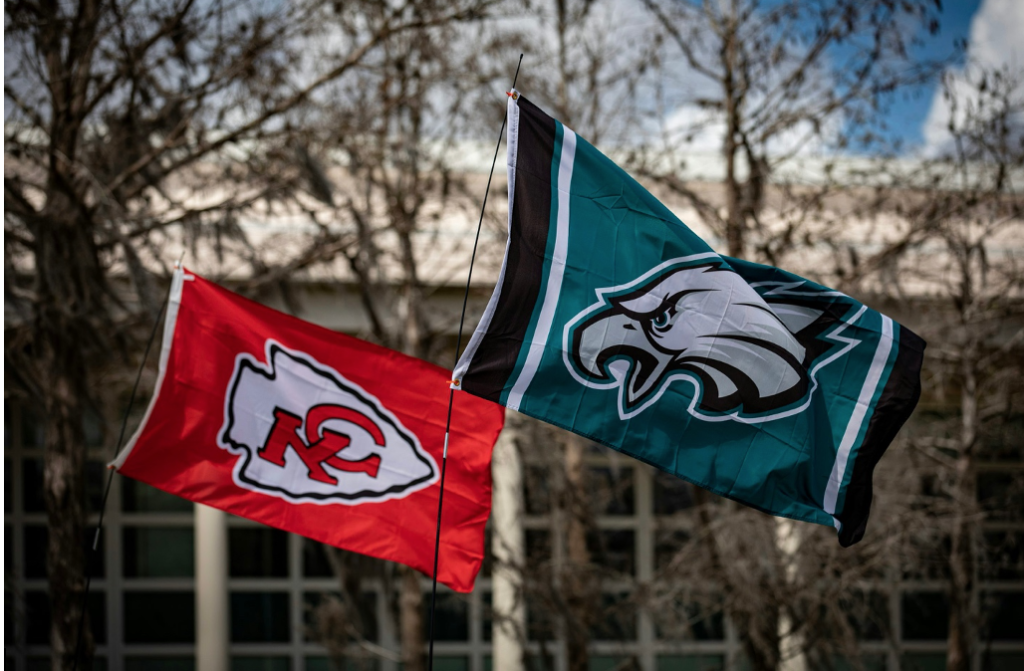By Amisha Patel, Staff Writer
Multiple Grammy and Pulitzer Prize winner Kendrick Lamar delivered a groundbreaking 13-minute performance at the 2025 Super Bowl halftime show. The show has now become the most watched Super Bowl halftime performance in history, gaining 133.5 million viewers and surpassing the viewer totals for Michael Jackson’s legendary show.[1] As the only solo rap artist to ever headline the Super Bowl halftime show, Lamar’s performance was highly symbolic and unconventional, receiving both admiration and controversy.[2] Lamar’s performance took place a week after he won a Grammy for Song and Record of the Year. Despite his record-breaking viewership and popularity, critics labeled it one of the worst halftime shows ever.[3] The backlash was particularly strong among conservative commentators and politicians who claimed the performance was difficult to understand and dismissed Lamar’s lyrics as “gibberish.”[4] Others argued that the songs were unrecognizable and accused the show of being exclusionary for featuring only Black dancers.[5]
The performance began with a striking visual of the set, which was designed with the X, O, and triangle shapes from a PlayStation controller, alongside a sign reading “Start Here.”[6] Under the sign, an arrow pointed down to Lamar who was kneeling on a Buick GNX, the namesake of his recent album.[7] Iconic actor Samuel L. Jackson then appeared on screen, dressed as a modernized version of Uncle Sam.[8] Many interpreted this as a representation of America’s evolution, with a Black man now embodying a role traditionally associated with a white figure.[9] He introduced Kendrick Lamar by saying “[t]his is the great American game,” referring to football.[10] According to art director Shelley Rodgers, the set design incorporated both football and video game references which symbolized Lamar’s journey through the American dream.[11]
Lamar kicked off the show with the line “The revolution is about to be televised. You picked the right time but the wrong guy” a reference to Gil Scott-Heron’s 1971 poem “The Revolution Will Not Be Televised.”[12] This phrase critiques the idea that real change comes from the people rather than from corporations or mass media. With current President Donald Trump in attendance, some viewed this as a direct attack given Lamar’s past criticisms of Trump in his music.[13]
As Lamar rapped his opening track, “Squabble Up,” he was abruptly interrupted by Jackson, who exclaimed “Too loud, too reckless, too ghetto! Mr. Lamar, do you really know how to play the game?”[14] This moment foreshadowed the backlash Lamar would soon receive, echoing long-standing criticisms of Black artists who challenge mainstream American ideals.[15] His comment also reflects the criticism often directed at Black hip-hop and rap artists like Lamar, whose music frequently portrays the violence, poverty, and drug use they witnessed growing up in low-income communities. Undeterred, Lamar continued his set with “HUMBLE” and “DNA” both from his Pulitzer Prize-winning album DAMN.[16] These songs delve into themes of identity, racial injustice, and the struggles of being a Black artist in America.[17] The choreography featured all-Black dancers dressed in red, white, and blue, forming an American flag split down the middle by Lamar.[18] This effectively created a powerful visual representation of the country’s cultural and political divide.[19]
Next, Lamar performed “Man at the Garden,” with dancers in streetwear nodding along beneath a lamppost, emulating the aesthetic of 1990s hip-hop culture.[20] Uncle Sam interrupted Lamar again by sarcastically remarking that he had brought his “homeboys,” calling them “the culture cheat code.” [21] This critique conveys the hypocrisy of white America’s selective embrace of Black culture by choosing to celebrate aspects of it while rejecting its roots.[22] Lamar continued the performance with a feature from SZA, performing their hit duet “Luther” from his latest album GNX and “All the Stars” from the Black Panther soundtrack.[23] Uncle Sam interrupts again with “That’s what America wants—nice, calm. You’re almost there—don’t mess this…” before Lamar cut him off beginning chords of his recently grammy winning song “Not Like Us” and Uncle Sam walks off, frustrated.[24] This exchange reflects Uncle Sam trying to confine Lamar to a sanitized, acceptable version of Blackness tailored to the white gaze, however Lamar consistently rejects it and embraces his identity.[25]“Not like Us” is the infamous diss track in Lamar’s viral rap feud with Canadian rapper Drake, which later escalated into a complicated legal battle.[26] Before performing his song, Lamar says “Forty acres and a mule, this is bigger than the music,” referencing the land and property promised to freed slaves after the civil war.[27] This direct reference highlights the longstanding systemic injustices perpetrated by the government against Black Americans.[28] Lamar ended his performance with “TV Off,” a song emphasizing themes of police brutality, racial stereotyping, and revolution. [29] The track’s repetitive lyric “Turn this TV off” tied back to the show’s opening, reinforcing the message of Gil Scott-Heron’s The Revolution Will Not Be Televised.[30] Lamar urges the audience to break free from the distractions of television and entertainment, directing them to take definitive action.[31] Overall, Lamar’s performance was more than the average Superbowl halftime show—it was a bold, artistic, and political statement that sparked both admiration and outrage amongst the American people.
[1] https://www.si.com/nfl/kendrick-lamar-performance-super-bowl-lix-most-watched-halftime-show.
[2] Id.
[3] https://www.gbnews.com/sport/other-sport/kendrick-lamar-halftime-show-super-bowl.
[4] https://economictimes.indiatimes.com/news/international/us/kendrick-lamars-performance-at-super-bowl-rages-maga-many-say-it-was-the-worst-halftime-show-heres-why-they-were-outraged/articleshow/118121229.cms?from=mdr.
[5] Id.
[6] https://www.hollywoodreporter.com/news/music-news/kendrick-lamar-super-bowl-halftime-show-symbolism-1236132476/.
[7] Id.
[8] https://theraidervoice.com/12897/arts-entertainment/the-symbolism-behind-kendrick-lamars-halftime-show-performance/.
[9] Id.
[10] https://www.theroot.com/the-complete-breakdown-of-the-symbolism-references-in-1851760266/slides/2
[11] https://www.hollywoodreporter.com/news/music-news/kendrick-lamar-super-bowl-halftime-show-symbolism-1236132476/.
[12] https://www.wowktv.com/sports/the-big-game/6-hidden-messages-in-kendrick-lamars-super-bowl-performance/amp/.
[13] Id.
[14] https://www.westword.com/music/kendrick-lamar-super-bowl-setlist-weaved-a-story-of-revolution-23449014.
[15] https://economictimes.indiatimes.com/news/international/us/kendrick-lamars-performance-at-super-bowl-rages-maga-many-say-it-was-the-worst-halftime-show-heres-why-they-were-outraged/articleshow/118121229.cms?from=mdr.
[16] https://www.history.com/this-day-in-history/kendrick-lamar-wins-the-pulitzer-prize.
[17] Id.
[18] https://www.hollywoodreporter.com/news/music-news/kendrick-lamar-super-bowl-halftime-show-symbolism-1236132476/.
[19] https://theraidervoice.com/12897/arts-entertainment/the-symbolism-behind-kendrick-lamars-halftime-show-performance/.
[20] https://www.andrews.edu/life/student-movement/issues/2025-02-14/ae_kendrick.html.
[21] Id.
[22] Id.
[23] https://www.vibe.com/lists/kendrick-lamar-super-bowl-lix-halftime-show-setlist/all-the-stars-feat-sza/
[24] https://thebigsmoke.com.au/2025/02/11/breaking-down-the-beautiful-bold-transgressions-of-kendrick-lamars-super-bowl-halftime-performance/.
[25] Id.
[26] https://www.cnn.com/2025/02/09/entertainment/kendrick-lamar-halftime-show-super-bowl/index.html
[27] https://www.9news.com/article/news/community/race-and-culture/kendrick-lamar-super-bowl-performance-symbolism/73-61e6bd70-35ea-4b78-8734-3d7f5d076740.
[28] https://theraidervoice.com/12897/arts-entertainment/the-symbolism-behind-kendrick-lamars-halftime-show-performance/.
[29] https://www.andrews.edu/life/student-movement/issues/2025-02-14/ae_kendrick.html.
[30] Id.
[31] Id.
